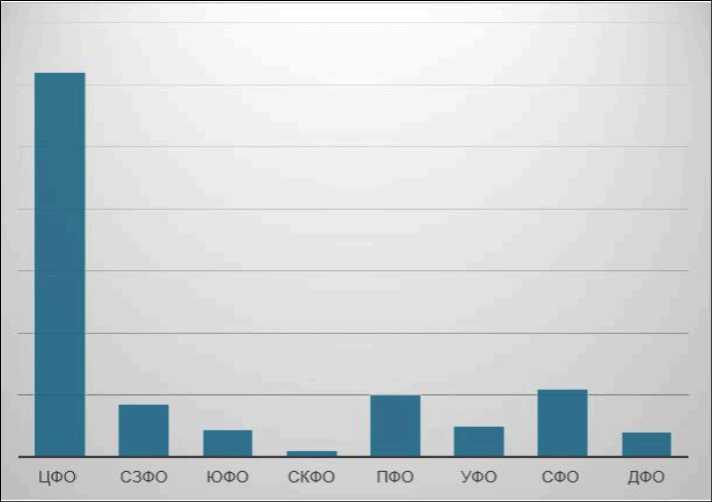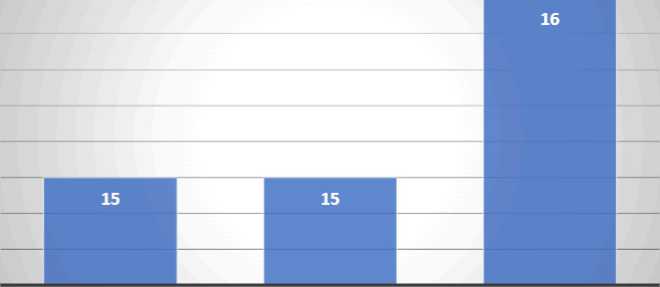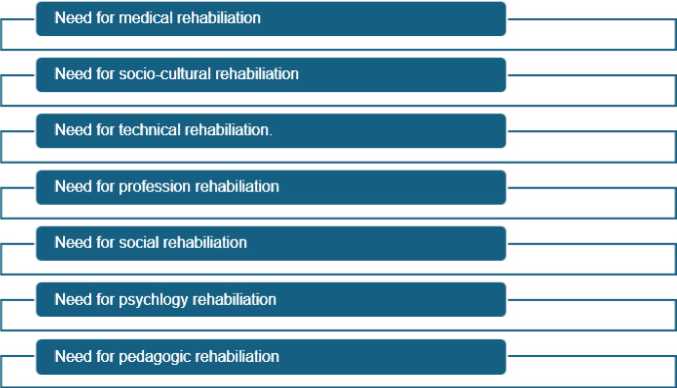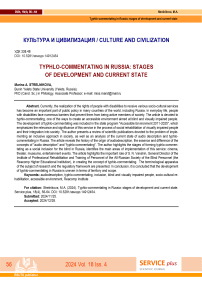Typhlo-Commentating in Russia: Stages of Development and Current State
Автор: Strelnikova M.A.
Журнал: Сервис plus @servis-plus
Рубрика: Культура и цивилизация
Статья в выпуске: 4 т.18, 2024 года.
Бесплатный доступ
Currently, the realization of the rights of people with disabilities to receive various socio-cultural services has become an important part of public policy in many countries of the world, including Russia. In everyday life, people with disabilities face numerous barriers that prevent them from being active members of society. The article is devoted to typhlo-commentating, one of the ways to create an accessible environment aimed at blind and visually impaired people. The development of typhlo-commentating was included in the state program "Accessible Environment 2011-2025", which emphasizes the relevance and significance of this service in the process of social rehabilitation of visually impaired people and their integration into society. The author presents a review of scientific publications devoted to the problem of implementing an inclusive approach in society, as well as an analysis of the current state of audio description and typhlo-commentating in Russia. The article reveals the history of the origin of audiodescription, the essence and difference of the concepts of "audio description" and "typhlo-commentating". The author highlights the stages of forming typhlo-commentating as a social inclusion for the blind in Russia, identifies the main areas of implementation of this service: cinema, theater, museums, entertainment events. The article highlights the important role of S. N. Vanshin, General Director of the Institute of Professional Rehabilitation and Training of Personnel of the All-Russian Society of the Blind Personnel (the Reacomp Higher Educational Institution), in creating the concept of typhlo-commentating. The terminological apparatus of the subject of research and the regulatory framework are presented. In conclusion, it is concluded that the development of typhlo-commentating in Russia is uneven in terms of territory and scope.
Audiodescription, typhlo-commentating, inclusion, blind and visually impaired people, socio-cultural rehabilitation, accessible environment, reacomp institute
Короткий адрес: https://sciup.org/140309183
IDR: 140309183 | УДК: 338.48 | DOI: 10.5281/zenodo.14912454
Текст научной статьи Typhlo-Commentating in Russia: Stages of Development and Current State
Building an inclusive society and creating a barrier-free environment are becoming important elements of social policy in many countries.
As part of the socio-cultural adaptation of disabled people of various nosological groups, such types of services are being developed as audio description - a verbal description of visual content that is inaccessible to blind people; sign language translation - the process of translating speech into sign language for people with hearing impairments; tyfhlo-sign translation - translation into tactile sign and sign language for people with simultaneous hearing and vision impairments; services using objects from an accessible environment.
Initially, the term "audio transcription'1 appeared in the United States, and only in 2002 a new concept of "typhlo-commentating" arose in Russia, which has a broader meaning, denoting the use of sound, written and printed methods [6].
The purpose of this article is to analyze the current state of typhlo-commentating in the market of inclusive socio - cultural services in Russia. Thanks to additional acoustic information and verbal descriptions, blind people recreate an image that is key to understanding the content of a film, performance, or sporting event. Audio description gives the blind the opportunity to interact with art, expanding the boundaries of the accessible environment.
Analysis of publications on research issues
An analysis of the topics of Russian scientific publications over the past 5 years devoted to inclusion issues has shown that most of the works raise issues of inclusion in education. Current topics and best practices of ensuring accessibility of the educational process and creating a system of support for students with disabilities of various nosologies in institutions of secondary vocational and higher education are discussed. Both individual works (Bagdasaryan D. S. [1]) and scientific and practical conferences are devoted to this issue. Scientific publications also reveal the socio-cultural aspect in the implementation of an inclusive approach [7, 17].
There are a number ofworks devoted to general theoretical issues, studying the mechanisms of social inclusion and attitudes in modern society towards people with disabilities [8,15].
However the use of audio descriptions in the sociocultural integration of the blind is an almost unknown aspect in both Russian and foreign scientific publications.
Most of the works cover the history and practice of typh lo-commentating in various countries [2, 10, 13, 14, 20]. Wang Ts.l. considers the problem of developing typhlo-commentating in China: in particular it is noted that providing typhlo-commentating practically does not exist on Chinese television channels; it is poorly developed in cinemas, museums and theaters [20]. The study of Pozde-yeva T.S. is an analysis of the market of audio descriptive services in the UK. The author identifies the features of providing audio descriptions in the socio-cultural sphere in the UK, identifies the largest providers of this service, sources of funding, as well as factors affecting the development of audio descriptions in the country [13]. Grinkevich V.A. considers typhlo-commentating as a type of cross-cultural communication on the example of the training profile "Typhlo-commentating and cross-cultural communication" at the Moscow State Linguistic Univer-sity[6].This approach is quite common and allows us to study typhlo-commentating in the context of translating visual art by linguistic means (Braun, S [3]; Orero, R. [12], Drobysheva, T.N. [5]).
Denisova T.’s article uses the term "recreated impression", which reveals the essence of typhlo-commentating as a means of visualizing cultural space. The author identifies the problems that hinder the effective introduction of audio description services in the socio-cultural sphere [4].
Despite the existing scientific discourse in the study and analysis of the development of typhlo-commentating, in our opinion, this problem is not sufficiently reflected in the media, scientific publications, although it is of scientific and public interest. It should be considered in the context of sustainable development of society and equal rights to receive socio-cultural services for people with visual impairments.
History and current state of typhlo-commentating in Russia
Sergey Nikolaevich and Olga Pavlovna Vanshins became the founders of typhlo-commentating in our country. In 2002, they coined the terms
"typhlo-commentating"and "typhlo-commentary”. Unlike the concept of "audio descriptions", the term "typhlo-commentating" implies the use of not only audio typhlo-commentating, but also written (for example, a description for the blind of a picture, photograph, geographical map, drawing, printed in Braille).
Sergey Nikolaevich Vanshin (Candidate of Pedagogical Sciences, General Director of the Institute of Professional Rehabilitation and Training of Personnel of the Reacomp Higher Educational Institution) is the actual founder of the concept of typhlo-commentating in Russia.
The first attempts at voice-over descriptions of films were made, according to some scientists (Droby-sheva, T.N. [5], RarenkoM.B. [14]), inthe70-80-ies. of the XX last century at the central polygraphic educational and production enterprise of the VOS (All-Russian Society for the Blind). The recordings of audio tracks were not of high quality, but they were very popular with the blind.
In our opinion, the first stage in the development of typhlo-commentating in Russia should be considered the period from 2004 to 2010, when systematic work on the preparation of typhlo-commentaries began and was primarily associated with the adaptation for the blind of films prepared for demonstration at the Cinema without Barriers festival.
This was made possible by training courses that were attended by one of the founders of modern audio commentary, Joel Schneider, Presidentof the TVA Society for Audio Description (USA).
The next stage, from 2010 to 2016, can be called a conceptual one. Special programs and teaching aids are being developed. The authors of these methods are S.N. Vanshin and P.A. Obiukh. In 2008 and 2010, P.A. Obiukh, a blind lawyer and human rights activist, offered an interactive program on synchronous TC. In 2010, the educational and methodical manual "Typhlo-commentating or verbal description for the blind" was published [19]; in 2016 -"Manual on typhlo-commentating" by P.A. Obiukh and M.O. Korneev [1-1].
The third stage, from 2011 to the present - is the organization of training, although the training process continues at the present time. Since 2011, the Reacomp Institute has started training specialists.
Currently, there are more than a hundred professional typhlo-commentators in Russia, but they are still not enough.
We analyzed data from the official website of the REACOMP Institute on the number of tiphlo-commentators who were trained here. So, students1 (31 people) of the Faculty of German of MGLU, studying in the direction of training (speciality): 45.03.02 Linguistics, focus: Typhlo-commentating and cross-cultural communication, qualified at the Reacomp Institute».
At various times, 212 people were trained at the Institute. Using geographical (for convenience, the division by federal districts was used) and quantitative analysis criteria, we can present the following picture of the presence of typhlo commentators in the regions of the Russian Federation (Fig. 1).
The undisputed leader is the Central Federal District and, in particular, Moscow and the Moscow Region (106 people). The second and third places are occupied by the Siberian and Volga Federal Districts, respectively.
Of course, such an uneven distribution of professionals negatively affects both the state of the accessible environment and the diversity of socio-cultural services for the blind.
The fourth stage, from 2017 to the present, in the Russian Federation, typhlo-commentating begins to acquire a regulatory framework. On March 28,2017, the Federal Law "On State Support of Cinematography in the Russian Federation" (No. 34-AP) was amended (Articles 8,9). (Federal Law No. 34-FZ of 28.03.2017 "On Amendments to Articles 8 and 9 of the Federal Law "On State Support of Cinematography of the Russian Federation").
In accordance with this Federal Law:
-
- starting from June 1, 2017, national films that receive state support for production or distribution are subject to mandatory subtitling and typlo-commen-tary by a person who received state support (at the expense of funds received for production or distribution) in accordance with the requirements approved by the Ministry of Culture of the Russian Federation;
-
- from January 1, 2018, film demonstrators are required to ensure accessibility conditions for dis-
- a bled cinema halls and show subtitled and typlo-com-mentary full-length national films created in artistic or animated form, in accordance with the rules approved by the Ministry of Culture of the Russian Federation in consultation with the Ministry of Labor of the Russian Federation2.
On October 31, 2017, GOST R 57891-2017 was approved and put into effect3. Leading experts in this field - S.N. Vanshin, O.P. Vanshina, P.A. Obiukh and others-took part in the development of the standard.

Fig. 1 - Availability of qualified typhlo commentators in the Russian Federation (by federal districts)
In accordance with this Federal Law:
-
- starting from June 1, 2017, national films that receive state support for production or distribution are subject to mandatory subtitling and typlo-commen-tary by a person who received state support (at the expense of funds received for production or distribution) in accordance with the requirements approved by the Ministry of Culture of the Russian Federation;
-
- from January 1, 2018, film demonstrators are required to ensure accessibility conditions for disabled cinema halls and show subtitled and typlo-com-mentary full-length national films created in artistic or animated form, in accordance with the rules approved by the Ministry of Culture of the Russian Federation in consultation with the Ministry of Labor of the Russian Federation.
On October 31, 2017, GOST R 57891-2017 was approved and put into effect. Leading experts in this field - S.N. Vanshin, O.P. Vanshina, P.A. Obiukh and others-took part in the development of the standard.
At the fourth stage, the TC is gradually extended to other entertainment events:
-
- Theatrical performances. TC is available in eighteen theaters: five for Moscow and thirteen for other regions. The first performance in Russia with typhlo-commentary was shown in 2013 at the Moscow Provincial Theater. Since then, its repertoire has included nine performances available to blind people. Sovremennik-Theater, Helikon-Opera, the Stanislavsky and Nemirovich-Danchenko Academic Music Theater, the State Theater of Nations, and the Pushkin Drama Theater have performances and operas with
-
3 GOST R 57891-2017 Typhlokommentation and typhlokommentation. Terms and definitions. URL: https://allgo6ts.ru/33f160/gost_r_578S1-2017 (date of application: 0S/05/2024)
-
typhlo-commentary on a regular basis with the support of the Art, Science and Sport charity Foundation.
-
- Museums. The TC process applies to museums. Currently, typhlo-commentary is carried out in a number of museums in Moscow: the State Darwin Museum, the Tsaritsyno Museum-Reserve, the Cosmonautics Museum, the Pushkin State Museum of Fine Arts, the Vadim Sidur Museum, the Garage Museum of Modern Art, the Zurab Tsereteli National Center of Contemporary Art, the Museum of Russian Impressionism, and many others. This list increases every year.
-
- Football matches, (in 2020, Radio VOS and the Russian Football Union started broadcasting football matches with TC).
The use of Internet technologies leads to the emergence of a new product. Special mobile applications have been created for the blind: "Typhlo-com-mentator" and "Typhlomedia" with recorded typhlo-commentaries for a number of movies. The Mosfilm Youtube channel is also available to blind viewers. In 2017, Sberbank launched the mobile app" Art. Aloud" with recorded typhlo-commentaries to the performances of the Golden Mask Festival.
In Russia, audio description and audiovisual translation are handled by the Digital Accessibility Department of RuFilms. We can mention the major Russian producers of films for the blind-the VOS Cultural and Sports Rehabilitation Complex (KSSRKVOS) and the Mosfilm film concern. Orders for typhlo-commen-tating are received from the singer Diana Gurtskaya Foundation "At the Call of the Heart" and the Russian Military Historical Society [10].
After the entry into force of a number of important laws in this area, many recording studios began to record typhlo-commentaries. Regional libraries for the blind also contribute to this process.
Typhlo-commentating: basic concepts and ides of typhlo-commentaries
What is typhlo-commentating? Typhlo-commentating is a concise description of an object, space, or action that is incomprehensible to the blind (visually impaired) without special verbal explanations [19]. The term "typhlo-commentating" was introduced by S.N. Vanshin in 2002.
As the term TC was further developed, it was defined as "an off-screen verbal description of the visual component of a film, performance, television program, and other events, prepared and carried out taking into account the specific features of blind people" [11, Р-14].
Currently, the main terms and definitions are reflected in the state standard "Typhlo-commentating and typhlo commentary" (GOST R 57891-2017).
Typhlo commentary is the result (product) of the typhlo-commentating process, a voice-over verbal description of the visual component of a film, performance, television program, and other events, prepared taking into account the specific features of blind people4.
There are the following types of typhlo-commentating: prepared and hot.
The typhlo-commentator has the opportunity to prepare for typhlo-commentating in advance, then we are talking about prepared typhlo-commentating, which, in turn, is divided into direct and automated. If it can be recorded in advance, then it is automated typhlo-commentating. If a typhlo-commentator reproduces it "live", this is a direct prepared typhlo-comentating.
Thus, automated typhlo-commentating is used in the cinema, while direct prepared typhlo-commentating is used in the theater. In the case of hot typhlo-commentating, the specialist acts without prior preparation. For this type of hot typhlo-commentating is important erudition, well-read, a large vocabulary and competent command of the Russian language.
The difficulty of working as a typhlo commentator is that preparing a high-quality typhlo commentary requires a high degree of observation, competent speech, and the ability to express yourself concisely, while conveying the essence of what is happening. Such a specialist should have a broad outlook, because you need to correctly commentate on any situation.
After training, every typhlo commentator gets the opportunity to perform professional duties independently, without attracting additional assistance.
Conclusion. According to Rosstat, as of January 1,2024, the number of disabled people in the Russian Federation was 11,040,864. The number of people aged 18 years and older suffering from eye diseases is growing from 2020 to 2022 (Fig. 2).
* GOST R 57891-2017 Typhocommentation and typhocommentation. Terms and definitions. URL (date of application: 09/05/2024)
2024 Том 18 №4
PHH РГУТИ

2020 2021 2022
Fig. 2 - Number of persons aged 18 years and older suffering from diseases of the eye and its adnexal apparatus (thousand people)

Fig. 3 - Rehabilitation needs of visually impaired people
This is a wake-up call. Afterall, vision provides more than 90 % of information about the outside world. Complete or partial loss of vision creates great difficulties in self-care, movement, orientation, communication, learning, and work.
Vision plays a crucial role in almost all activities: with the help of vision, a person monitors the correctness of the actions performed.
Visual sensations and perceptions are also an inexhaustible source of aesthetic experiences. This is especially true for color vision, which contributes to a better perception of objects.
Rehabilitation measures should take into account both the general and individual needs of visually impaired people (Fig. 3). As we can see from the diagram, socio-cultural rehabilitation is one of the components of the process of integrating the blind into society.
The process of socio-cultural rehabilitation is based on various specialized cultural and leisure activities, including visiting museums, theaters, watching movies in cinemas, visiting excursions and other entertainment events. In this regard, the importance and role of typhlo-commentating increases, which contributes to the accessibility of culture to blind and visually impaired people.
Today, the work on preparing typhlo-commen-taries is beginning to take on a massive character. This is facilitated by the publication of a number of legislative acts, for example, the adopted amendments to the law "On State Support for Cinematography of the Russian Federation". Unfortunately, Russian theaters do not yet have such legislative support and separate state funding for thyplo-commentated pubs. As in the theater sector, typhlo-commentating is poorly developed in museums and other objects or events of the socio-cultural sphere, where this service is necessary.
Moscow is the most prosperous city for people with disabilities, where the blinds are provided with the opportunity to join cinema, theater and fine arts in the framework of museum expositions with the help of typhlo-commentating. In the regions, you can observe either isolated examples of providing a typhlo-commentating service, or their complete absence. The centers for creating typhlo-commentaries are regional libraries for the blind, which are part of the VOS structure. Despite the fact that in Russia, practical audio description began to be used even earlier than in many European countries, the pace of development of this service in our country is not so high. However, it should be noted that typhlo-commentating as an inclusive practice, is gradually developing, covering different regions and motivating new enthusiasts.


